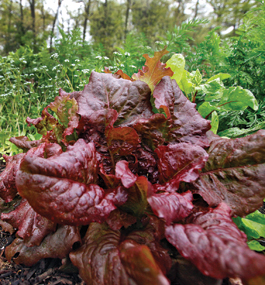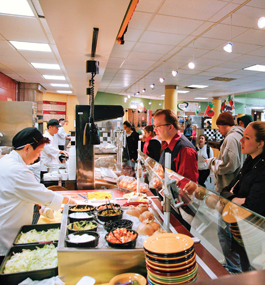Home Cooking
From locally grown to internationally inspired, from the Balance station to sushi at Washoku, campus food feeds the university’s healthy and diverse appetite.

Mike Lovett
by Max Pearlstein ’01
A decade after graduating from Brandeis, one of the things I miss most about being a college student is my college-aged metabolism. I remember hearing about the dreaded “freshman 15,” but I didn’t gain it then; in fact, when I came home for my first winter break in 1998, my mother asked me if I was eating enough. I was, and then some.
Perhaps I maintained my figure by climbing the Rabb steps several times a day for my two Jerry Cohen courses and other humanities classes, but I’m guessing it had more to do with my cutting back to the weekly 14-meal plan when I realized shortly after orientation that I would not be eating breakfast on most days. But then again, I certainly made up for those missed breakfast calories with an even earlier morning Chocolate Orgasm milkshake at the Shapiro After Dark snack bar. And there were Sherman’s Belgian waffles that I loved to cram with chocolate chips and fold over, like a sandwich, and all-I-could-eat egg rolls and ice cream at Usdan’s Sunday-night buffets. My favorite treats, though, were the chocolate and coconut magic bars (I may be skewering the name, but they were magical) that I would grab by the fistful, wrapping up what I couldn’t eat in one sitting with napkins, and storing them for later in my dorm room’s minifridge.
Looking back now over the horizon of my expanded stomach, I think what I appreciated even more than all the food I ate was the fact that someone else was making it for me. I didn’t care how the magic bars were constructed, or where the coconut that was in them came from — I was simply content to have them beckon to me, by the tray full, on the nonkosher side of Sherman cafeteria.
 |
|
Sidebar Stories From Farm to Plate the CSA Way |
 |
Probably not everyone in the Class of 2001 shared my laid-back attitude toward food. According to faculty member Laura Goldin, who arrived at Brandeis a few years before I departed from the university’s dining halls, my unenlightened appetite, which inevitably veered toward fat, skipping right over fruit displays, would definitely be out of place on campus today.
These days, most Brandeis students insist on quality, health and sustainability when it comes to their meals — metrics that are tipping the scales away from just quantity. And quantity, as anyone who recalls the famous cafeteria scene from “Animal House” in which Bluto stuffs dozens of items, from green Jell-O to a plate full of peas, onto his tray, and into his pockets and mouth, knows — is the traditional measure of college food.
“Our students are learning what it means to eat responsibly, and they’re actually cultivating small amounts of their own organic produce right on campus,” Goldin told me. “Students are now coming here with a real desire to participate in and promote sustainable food production.” (This is in sharp contrast to my student days, when sustainability meant being able to make it through my 7 a.m. WBRS radio show without the benefit of that aforementioned missing breakfast, and, more importantly, coffee.)
Goldin is chair of the university’s environmental studies program and director of the environmental internship program. She has been spreading the gospel of environmental sustainability, which encourages local food production and distribution, since she arrived at Brandeis more than 12 years ago from the Massachusetts Department of Environmental Protection, where she served as general counsel and chief environmental attorney.

Mike Lovett
page 2 of 3
At Brandeis, Goldin transformed an American studies-based environmental research workshop into a course that today is a shining example of experiential learning. Students in “Greening the Ivory Tower: Improving Sustainability of Brandeis and Community” explore hands-on strategies for creating healthy, vigorous, environmentally sustainable communities. They collaborate with partners like the Campus Sustainability Initiative and Students for Environmental Action in an effort to encourage composting and reduce electrical usage, for example, and with community organizations like Healthy Waltham to promote healthy eating and gardening in local schools.
“When I started the class, I wanted students to develop an understanding of how communities can work toward improving sustainability, with our own campus and community as our ‘lab,’” says Goldin. “I wanted to challenge the students to examine their own behaviors, and inspire them to make lasting changes around them. Since then, I’ve been continually impressed by the energy, enthusiasm and commitment they devote to their projects.”
Take the students’ organic “patchwork garden” that was created on the southern-facing hillside of Massell Quad in 2009 as one of the projects in the “greening” class. Last fall it seeded yet another green initiative when a new crop of Goldin’s students built cold frames (greenhouse-like vegetable beds in plastic-topped wooden frames that retain heat to extend the growing season) to grow herbs for dining services’ soups and sauces. Class projects over the years also led dining services to provide biodegradable and then reusable personal takeout containers, reduce use of individual condiment packets by providing and promoting volume dispensers, and introduce trayless dining, along with promoting reusable cups, utensils and dishes over disposables.
This gives you an idea of just how important food has become on campus; until recently, at Brandeis, as at most colleges, the major collaboration between students and dining services transpired when students stacked their trays or worked as dishwashers. But about six years ago, Goldin began cultivating a partnership when she asked Aramark dining services’ representatives to start talking with her students about the ways in which sustainability and organic food could be directly incorporated into campus eating.
The Aramark team had already started to remake the conventional model of dining services: heavy on limited selections and light on fresh produce. A year earlier, in 2006, it introduced locally grown produce in all campus dining locations, thanks to a relationship with New Bedford, Mass., produce distributor Sid Wainer & Son. The company provides dining services with fresh ingredients from farms across Massachusetts, meaning campus menus now change daily based on the harvest and season. In addition to the relationship with Sid Wainer, Aramark now has contracts with numerous local operations, including Hood, which distributes milk from a farm in Derry, N.H., and Boston’s Foley Fish, which supplies salmon for Balance, Usdan’s healthy options station, and for the sushi station, Washoku.
“Food selection is a priority for us,” says Andrew Bluestein, Aramark’s campus director of operations. If organic is becoming the mantra of institutional dining, variety is nevertheless the only way to keep that boogeyman of college meal plans — food fatigue — at bay. The myriad selections now available in Usdan are enough to make a 10-year-out alum like me almost dizzy with indecision. The only seasonal dining change that I can remember from my time was when the sukkah went up outside of Sherman, bidding Jews to dwell and dine in outdoor booths in a celebration of the harvest.

Ken Schles
page 3 of 3
Even the campus convenience store, P.O.D. Market, offers a variety of organic options, and Usdan’s “GrillWorks” station cooks up hormone-free, grass-fed burgers. This fall, as a result of student feedback, dining services will convert to an all-cage-free egg operation. The most local of all the offerings, though, are the fresh bread, pastry and desserts made daily in Aramark’s on-campus bakery — diabolically located in Kutz, within smelling distance of many students’ classes and dorm rooms — and strategically positioned next to the cash registers in Usdan and Sherman. But there is some justice to this otherwise unrelenting temptation: Dining services’ baked goods, including the highly popular rye bread and legendary challah, have been sold at Brandeis farmers markets, with all proceeds supporting “Greening the Ivory Tower” projects.
At the same time that dining services has gone local, the department has also become more global. One of my favorite campus dining options — the Mexican-inspired “El Taquito” — may be on a permanent siesta, but international offerings, reflecting the university’s increasingly diverse student body, have grown significantly over the past decade — and they’re even homemade.
“We are very fortunate to have chefs on our staff from various countries who know how to cook authentic regional cuisine,” Aaron Bennos, Aramark’s campus director of dining services, says. “We want to cater to the various cultures on campus and make students feel like Brandeis is a home away from home. Our international cuisine also exposes students to different cultures and helps keep the food options fresh and changing.” Those choices also honor various dietary restrictions, from Sherman’s long-standing kosher dining to the more recent, award-winning emphasis on vegan cuisine. In 2010, peta2 voted Brandeis the third most vegan-friendly small college in the nation, citing the extensive vegan offerings that include beef fajitas, soy meatballs, grilled seitan tips, Southwestern riblets and numerous packaged snacks.
While Usdan and Sherman cafeterias offer fare for all tastes, the International Business School (IBS), proving that business and pleasure can mix quite nicely, hosts ethnic festivals that range from the Hindu commemoration of Diwali and the Asian celebration of the lunar New Year, to Latin American and African fetes. The thin pancakes from India known as chaapati, the rice dish from East Africa called wali, along with tapas-style rissois and pudim flan from central Africa, are all likely to make appearances at celebrations throughout the academic year.
The popular IBS cultural fetes also reveal something that hasn’t changed in the last decade at Brandeis: Students, regardless of where they’re from, still love free food. So, if they’re smart, they’ll know to hang out near the campus convenience store at the end of the spring semester, when their friends have meal plan points to burn.
